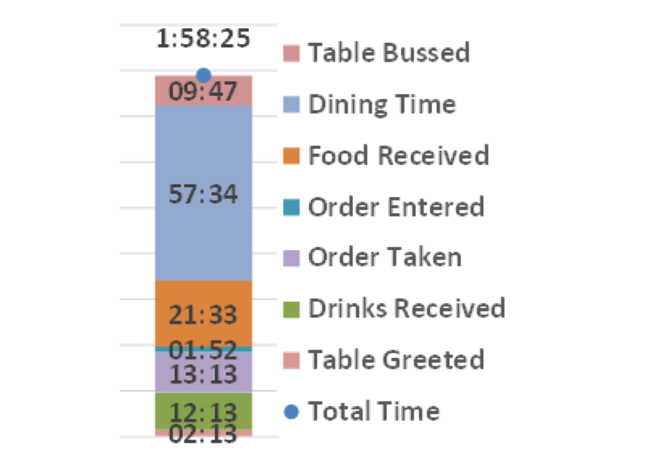When looking for efficiencies in full-service restaurants, especially fine dining concepts, operators are always careful not to impact the customer experience that has come to define their brand. One big reason customers return to their favorite restaurants is because of how they have been treated every time they visit.
Some customers don’t mind if they must make a reservation two weeks in advance if it gives them the opportunity dine in their favorite restaurant on a Friday or Saturday night. They don’t mind if they wait for 35 minutes to get their food once they have ordered, in fact they already planned to stay for 90 to 120 minutes in the restaurant, so there is no rush to get the food quickly.
Most of the work done to make full-service restaurants more efficient occurs in the back of the house. So long as the food quality remains the same or improves, operators will consider new ideas that will help improve the efficiency of labor or the back-of-house space. But as important as it is to streamline the BOH, leaving the front untouched leaves a huge opportunity on the table. There does not need to be a change to the customer experience in order drive impact. Below are three areas that will drive efficiency and throughput in the front of house without impacting guest experience, perception, or satisfaction.
Party Size Distribution (less is more)
When designing a restaurant, most people like to talk about capacity in terms of seats. “Our facility has 280 seats” but the reality is that almost half of those seats are not being utilized. People seat in parties not seats. Look at the chart below, it represents a common scenario that we see across most full-service concepts. Close to half of the parties, sometimes more, consist of two people, yet the majority of the tables are four-tops.
When a restaurant has 280 seats, all being four-tops, means it can seat 70 parties at once. The restaurant has no control over how many people will be in each party. It would be great if only parties of four would dine at the restaurant, but that’s just not the case.
In the two examples below, more than 40% of the restaurant’s four-tops were occupied by parties of two. By evenly distributing the 70 parties, though, the restaurant can have the same capacity, same throughput and same sales, with significantly fewer seats.

Potential Table Set up
- 28 (40%) 2-Tops
- 32 (45%) 4-Tops
- 10 (15%) 6-Tops
- Total 70 Parties and 244 seats (-13% seats)
Evenly distributing the parties does not impact the guest experience but it does create a potential impact for greater throughput if the additional space is converted into more tables. Or better the restaurant can achieve better unit economics if it can reduce its footprint.
Focus on Table Idle Time
The time from when a party gets up from the table until the next party is seated is an often-overlooked opportunity. The typical dine in time for a fine-dining restaurant ranges between 90 and 120 minutes. Again, restaurants have little control over how long a party stays. Suggesting a time limit would being to affect the customer experience. But if the restaurant can reduce the time it takes to turn the table by focusing on bussing and updating table status, capacity can increase without impacting the customer at all.
The chart below shows a series of opportunities to potentially impact speed of service, assuming people will stay as long as they originally planned. The opportunity here is 9:47 from the time the party gets up until the table is ready for the next party. Using the 70-party example above, every two hours there are 684 minutes of opportunity.

In practical terms, this translates into an opportunity to sit an additional five to six parties during the peak period. In addition to that there is a time when the table is bussed and reset until the next party is seated. That time tends to be sometimes even more than 10 minutes.
The Right System for Reservations and Walk-Ins
Many reservation-based restaurants turn away walk-ins during peak periods. Part of the reason this happens is because they assign a table to a party as part of the initial plan for the night. Doing this blocks the table from being used for a much longer period than its needed. Having the right system that can allocate parties to tables as they check-in and ensures the rotation of the tables.
The system needs to have enough tables available to honor all the reservations, but these tables don’t need to be assigned until the party shows up and checks in. Having the right system can help the host know how many walk-in customers can be seated while still maintaining enough tables for all the reservations.
A variety of factors can contribute to making the process of assigning tables inefficient. For example, what if a reservation does not show up? That specific table was held for more than 25 minutes until it was deemed ready for use by another party. Or what if some parties take 60 minutes instead of the 90 allocated to the table? Those 30 minutes gained are not enough to sit another party in the table if there is a reservation already assigned to that table. Just like the second point above, every time you see an empty table on a busy night there is likely an opportunity to drive more revenue.
Focusing on the processes and efficiencies in the back of house are always going to have implications on customer satisfaction, and potentially table turns. But not focusing enough attention on the front of house opportunities is leaving money on the table. Especially if there is enough opportunity to be had where the customer experience is not impacted at all.



